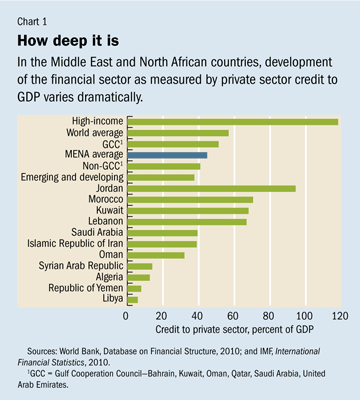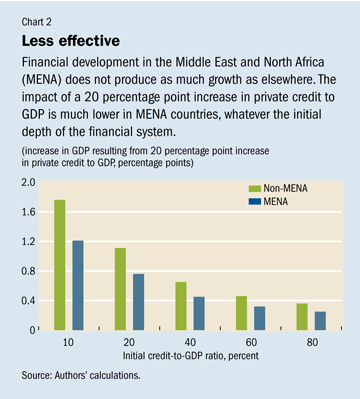Differing Benefits
Finance & Development, September 2011, Vol. 48, No. 3
Adolfo Barajas, Ralph Chami, and Reza Seyed Yousefi
Financial development does not give the same growth boost to all countries
FINANCIAL development and economic development are inextricably linked. Research has shown that countries with financial systems that mobilize a substantial amount of funds—that are deeper, to use the standard parlance—will tend to have higher, more equitable rates of growth over the long run. Undoubtedly, part of this is success breeding success—higher-growth countries naturally generate higher demand for financial services, which in turn induces the financial sector to develop more rapidly. But research has uncovered an independent relationship that runs in the opposite direction—from financial development to increased growth. Banks and financial markets allocate funds to productive uses, provide firms and households with instruments to manage risk, facilitate transactions, and exert some control over the end uses of these funds. For policymakers, this is of critical importance, because it implies that an integral part of any growth strategy should be the creation of conditions that allow the financial sector to deepen (see “A Bigger Slice of a Growing Pie,” in this issue of F&D).
While the benefits of financial development are well established, until recently there has been little investigation into whether the link between finance and growth varies quantitatively across countries. In empirical studies, the degree of financial development is generally measured by an economy’s depth (that is, the relative size of its banking system or stock market). For example, a common measure is the volume of banking system credit to the private sector as a percentage of gross domestic product (GDP). For the most part, the research has assumed that the process of financial deepening will have roughly the same impact on growth regardless of the region or the structure of an economy. Similar-sized increases in banking system credit should have the same growth impact whether they occur in, say, Brazil, Morocco, France, Saudi Arabia, or Korea.
But the relationship might vary across countries. Because of differences in efficiency or in institutional factors, the same amount of bank credit may not be channeled into productive uses as effectively in some countries as in others. We analyzed whether the strength of the relationship varies
• across regions, where common characteristics of how financial sectors operate might result in different growth effects; and
• for oil-exporting countries, where the dominance of oil-related activities in the economy, commonly associated with less efficient resource allocation, also extends to how well the financial sector allocates credit.
Of course, any differences among countries in the finance–growth link would have important implications for policy. To the extent that growth impact turns out to be weaker in a given country, simply increasing the amount of bank credit will not suffice to generate growth. Policymakers would also have to address the underlying cause of private credit’s inability to spur economic activity over the long run.

We analyzed this relationship for a worldwide sample of more than 140 advanced and developing economies during 1975–2005 and reached two main conclusions.
First, we found that one region stands out as being relatively less successful in translating banking depth into long-run growth: the Middle East and North Africa (MENA). Although the average depth in the region has been similar to the global average for emerging and developing countries (EDC), there is great variation within the region (see Chart 1). For example, in 2008, the country in this region with the deepest banking sector (Jordan) provided credit to the economy at a scale equivalent to 16 times that of the shallowest (Libya). Furthermore, for many MENA countries, the amount of credit provided by the banking system should be greater than it is, given their ability to attract deposits. Excluding the countries of the Gulf Cooperation Council (Bahrain, Kuwait, Oman, Qatar, Saudi Arabia, United Arab Emirates), the average loan-deposit ratio in MENA banking systems has been well below the EDC average for the past 30 years.

But more crucially, for a given level of depth, MENA banks have not delivered benefits to the same degree as elsewhere. The growth impact in the MENA region falls short of that in most other regions. Depending on the country sample, the size of the estimated shortfall ranges between one-third and two-thirds (see Chart 2), and is present whether the growth rate of total GDP or merely non-oil GDP is being analyzed. For example, if Yemen’s banking system were to deepen to the EDC average—a 22 percentage point increase in the credit-GDP ratio—annual per capita growth would increase by at most 1½ percentage points, whereas a similarly shallow country in another region, say, Myanmar, would accelerate its growth rate by more than 2⅓ percentage points.
Second, we found that in oil-exporting countries across different regions the growth benefits of increased bank credit are weaker as well. Specifically, the greater a country’s oil dependence—the ratio of oil-related activity to GDP—the smaller the growth impact of financial deepening. In fact, this impact seems to disappear altogether at a level of oil dependence of about 35 percent, roughly the level of Saudi Arabia, Algeria, and Trinidad and Tobago.
Although the exact cause of the weak finance–growth link in MENA and in oil-exporting countries—what we call the quality gap in banking intermediation—is not clear, a few possible factors stand out.
• MENA financial services have not been extended as broadly as in other regions, according to recent work by the World Bank. Survey results indicate that fewer firms have received bank financing, a greater proportion cite access to credit as a major constraint to their business plans, and a smaller percentage of the population has access to checking accounts or automated teller machines. Bank loans tend to be concentrated among a small number of borrowers, excluding many potentially growth-enhancing firms. These shortcomings apply both to the shallow banking systems in the region’s oil importers as well as to the very deep systems in the high-income oil exporters, which suggests that inadequate access to finance is a key piece of the puzzle.
• There is a comparative lack of competition in MENA banking systems. Anzoategui, Martínez Pería, and Rocha (2010) recently tested the degree of competition within banking systems throughout the world and found the MENA region was significantly less competitive than other regions—with the possible exception of sub-Saharan Africa. Furthermore, they identified two factors behind the lack of competition: inadequate credit information and relatively strict obstacles to entry into the banking market.
• The pattern of ownership may play a role. Again, despite considerable diversity, most countries in the MENA region have a relatively high share of state-owned banks and/or a relatively small share of foreign-owned banks. A high state share in the banking system has often been associated with limited financial depth, but whether it has an independent negative impact on growth is not clear cut. However, Körner and Schnabel (2010) identify two factors that combine with high state ownership to produce negative growth effects: low levels of financial depth and low institutional quality. Within the group of countries covered by their study, several MENA countries—Bahrain, Egypt, Kuwait, and Syria—exhibit these three characteristics.
• The state and pace of financial reform may also be related to the weak finance-growth link. Although comparative data are relatively scarce for MENA countries, a composite index of financial reform (Abiad, Detragiache, and Tressel, 2008) permits comparisons between five MENA countries and other regions. Although the state of reform achieved by these countries by 2005 was not particularly low, it also appears that the pace stalled between 1995 and 2005, when all other regions made significant strides. Europe and central Asia made the greatest progress over this period. ■
Adolfo Barajas is a Senior Economist, and Ralph Chami is a Division Chief in the IMF’s Middle East and Central Asia Department. Reza Seyed Yousefi is a doctoral candidate in Economics at the University of Texas at Austin.
This article is based on a forthcoming IMF Working Paper, “The Finance-Growth Nexus Re-Examined: Are There Cross-Region Differences?”
References
Abiad, Abdul, Enrica Detragiache, and Thierry Tressel, 2008, "A New Database of Financial Reforms,” IMF Working Paper 08/266 (Washington: International Monetary Fund).
Anzoategui, Diego, María Soledad Martínez Pería, and Roberto Rocha, 2010, “Bank Competition in the Middle East and Northern Africa Region,” World Bank Policy Research Working Paper No. 5363 (Washington: World Bank).
Körner, Tobias, and Isabel Schnabel, 2010, “Public Ownership of Banks and Economic Growth—The Role of Heterogeneity,” CEPR Discussion Paper No. 8138 (London: Center for Economic Policy Research).


